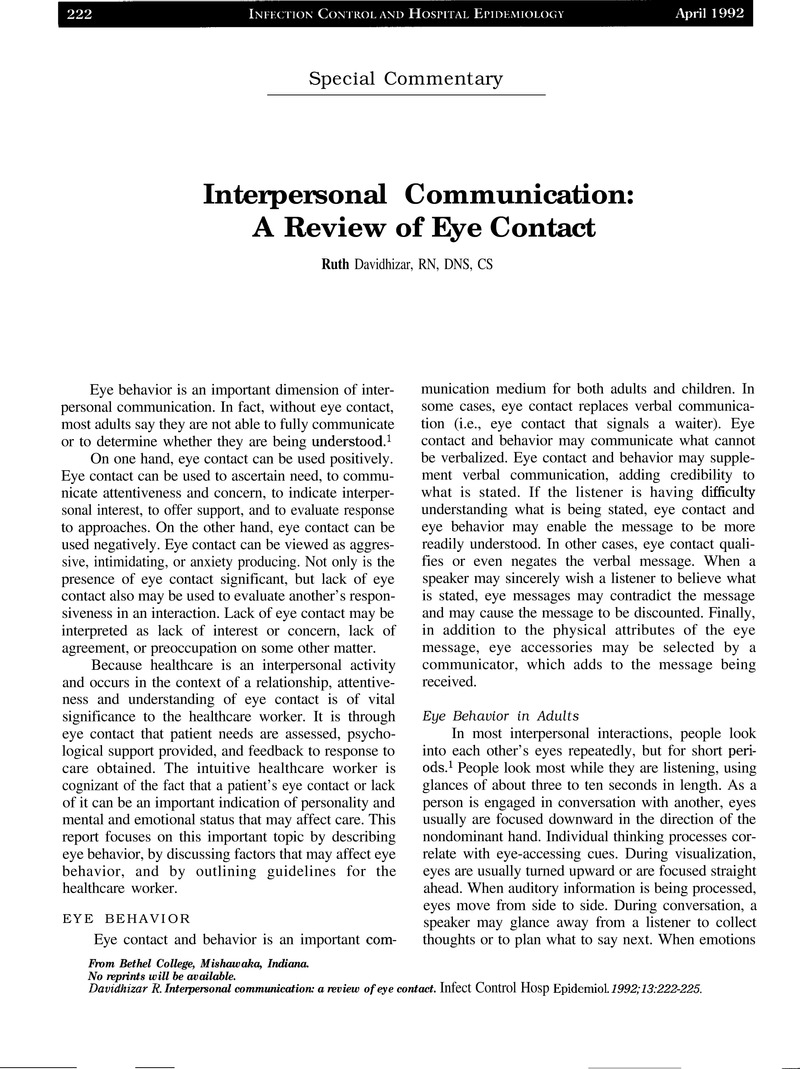No CrossRef data available.
Article contents
Interpersonal Communication: A Review of Eye Contact
Published online by Cambridge University Press: 21 June 2016
Abstract
An abstract is not available for this content so a preview has been provided. Please use the Get access link above for information on how to access this content.

- Type
- Special Commentary
- Information
- Copyright
- Copyright © The Society for Healthcare Epidemiology of America 1992
References
1.
Argyle, M, Dean, J. Eye contact, distance, and affiliation. Sociometry. 1965;28:284–304.CrossRefGoogle ScholarPubMed
2.
Spitz, R. The smiling response: a contribution to the ontogenesis of social relations. Genetic Psychology Monographs. 1946;35:57–125.Google Scholar
3.
Wolff, P. Observations on the early development of smiling. In: Foss, BM, ed. Determinants of Infant Behavior II. London, England: Methuen; 1963:122—123.Google Scholar
4.
Norris, J, Kunes-Connell, M, Stockard, S, Ehrhart, P, Newton, G, eds. Mental Health-Psychiatric Nursing: A Continuum of Care. New York, NY: John Wiley and Sons; 1987.Google Scholar
5.
Personal Report for the Executive. New York, NY: National Institute for Business Management; 1987.Google Scholar
6.
Tripp-Reimer, T. Barriers to health care: variations in interpretation of Appalachian clients' behavior by Appalachian and non-Appalachian health professionals. Western Journal of Nursing Research. 1982;4:179–191.10.1177/019394598200400205CrossRefGoogle ScholarPubMed
7.
Rocereto, L. Selected health beliefs of Vietnamese refugees. Journal of School Health. 1981;51:63–64.CrossRefGoogle ScholarPubMed
8.
Giger, J, Davidhizar, R. Transcultural Nursing: Assessment and Intervention. St. Louis, Mo: C.V. Mosby; 1991.Google Scholar
9.
Eibl-Eibesfelt, I. Similarities and differences between cultures in expressive movements. In: Hinde, RA, ed. Nonverbal Communication. Cambridge, United Kingdom: Cambridge University Press; 1972:297—312.Google Scholar
10.
McKenzie, J, Chrisman, N. Healing herbs, gods, and magic: folk health beliefs among Filipino-Americans. Nursing Outlook. 1977;25:326.Google ScholarPubMed
11.
Sue, D. Counseling the Culturally Different: Theory and Practice. New York, NY: John Wiley and Sons; 1981.Google Scholar
12.
Hess, EH. Attitude and pupil size. Scientific American. 1965;212:46–54.CrossRefGoogle ScholarPubMed
13.
Hess, EH. The role of pupil size in communication. Scientific American. 1975;233:110–119.CrossRefGoogle ScholarPubMed
14.
Walker, E, Marwit, J, Emory, E. A cross-section study of emotion recognition in schizophrenics, journal of Abnormal Psychology. 1980;3:428–436.CrossRefGoogle Scholar
15.
Murray, R, Huelskoetter, M. Psychiatric/Mental Health Nursing. East Norwalk, Conn: Appleton and Lange; 1987.Google Scholar
16.
Goffman, E. Behavior in Public Places. London, England: Free Press of Glencoe; 1963.Google Scholar
17.
Exline, R. Explorations in the process of person perception: visual interaction in relation to competition, sex, and the need for affiliation. Journal of Personality. 1996;3l:1—20.Google Scholar
18.
Knapp, M. Nonverbal Communication in Human Interaction. New York, NY: Holt, Rinehard, and Winston; 1978.Google Scholar




